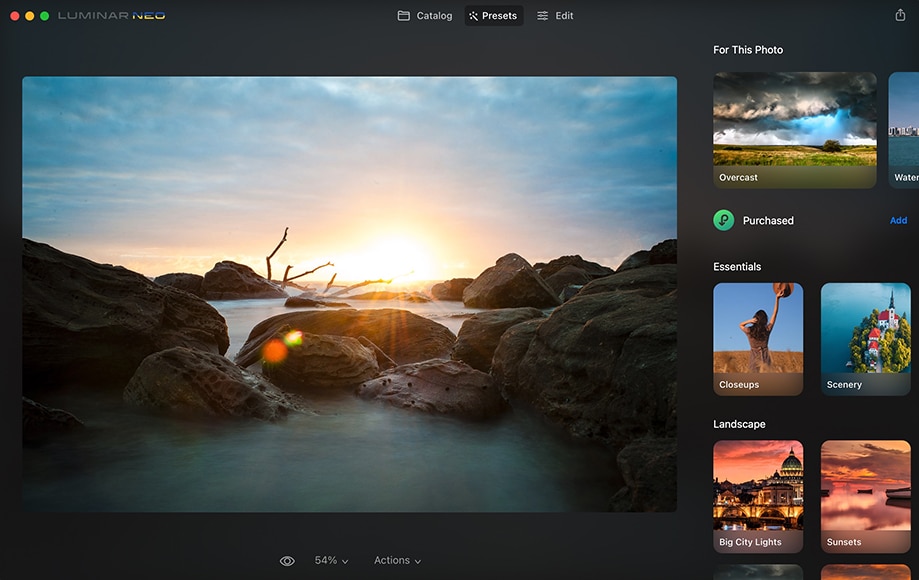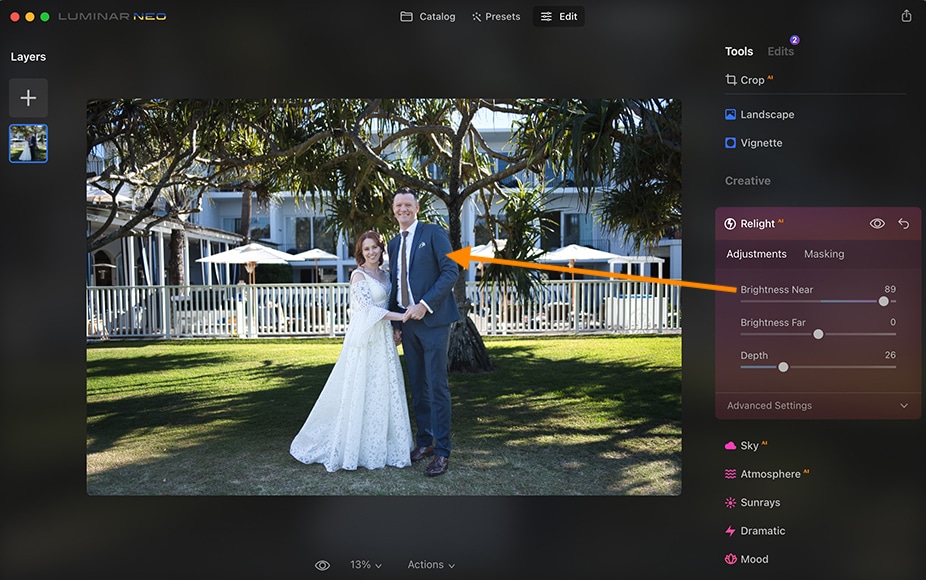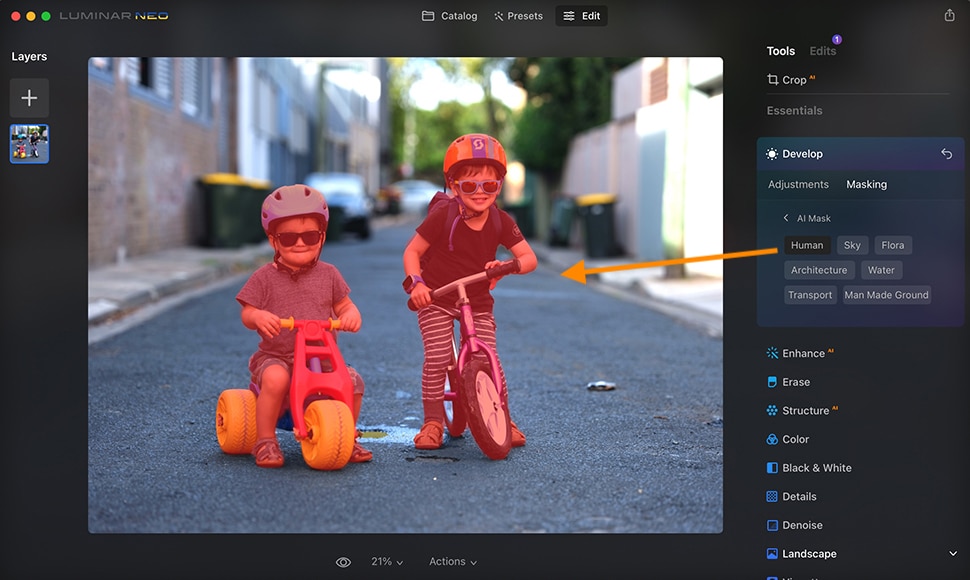
Luminar Neo vs Luminar AI: 6 Key Differences to Know in 2024
If you're having trouble choosing between Luminar Neo and Luminar AI, here are the 5 key differences you need to know when deciding which photo editor to buy.
Luminar | Software | By Mark Condon
If you’re having trouble choosing between Luminar Neo vs Luminar AI, I don’t blame you!
After all, both photo editing apps were released within almost a year of each other, sharing similar branding and features.
However, since Luminar AI is no longer available, the decision is simple – buy Luminar Neo, which has all the latest tools and updates.

Powerful AI editing tools improve photos in less time. Affordable one-time pricing and exciting updates.
Use code shotkit10neo to save $10.
However, if you’re an existing Luminar AI user and wondering whether to upgrade to Neo, the decision is a little harder.
I was in the same place not long ago, so that’s why I’ve written this guide :-)
Let’s take a closer look at the key differences between Luminar AI and Luminar Neo so you can decide which AI photo tool is right for you.
Where to Get Luminar Neo and Luminar AI in 2024
As of 2023, Skylum has stopped selling Luminar AI, meaning that new users must now purchase Luminar Neo.
(This isn’t a bad thing since Neo is the newer, better software which now features Extensions.)
You can download Luminar Neo here (Use code shotkit10neo to save $10)
Neo offers a 30-day money-back guarantee and is available for Windows and Mac.
If you’re an existing Luminar AI user, use this link to upgrade for a discounted price.
Skylum Luminar Neo vs Luminar AI: 6 Key Differences
When I interviewed Skylum, here’s what they had to say:
“Luminar Neo expands creativity compared to Luminar AI. Luminar Neo is completely different from previous Luminar apps.
However, it keeps your favourite Luminar AI tools and expands your arsenal with more state-of-the-art technologies and important changes at its core.
Luminar Neo improves on all previous versions of Luminar based on feedback from photo lovers all over the world. The result is a new photo editor that helps you achieve photos just as you imagined them.”
This is all well and good, but as someone who’s trying to decide between Luminar Neo vs Luminar AI, we need specifics to make a sound judgement call on which photo editing software to buy.
Let’s take a look at the 5 key differences between Luminar Neo and Luminar AI here in 2024:
1. Modular Engine: faster, less resource-intensive, easier to update

Presets and other tools are quicker in Luminar Neo than in Luminar AI.
What differentiates Luminar Neo from all previous versions of Luminar is its ‘modular engine’.
‘Modules’ help to evenly distribute the load while using the various editing tools in Luminar Neo for faster image processing.
This is key when comparing Luminar AI vs Luminar Neo, and it’s important to understand just how big a benefit it actually is.
The modular engine allows you to apply lots of different tools to an image without significant performance loss, with all edits saved automatically.
Where this is most noticeable is when you’re using the various AI-powered tools in Luminar Neo, such as Sky AI and the new Relight AI tool.
The new modular engine also uses less memory (RAM) and storage space on your computer. Users with low-powered computers who were frustrated with slow performance in Luminar AI should have a better experience with Neo.
In my Luminar Neo review, I found that while the AI tools in Luminar Neo could definitely be quicker, there was a noticeable improvement in speed when compared to the same tools in Luminar AI.
Finally, a modular engine means that the new architecture of Luminar Neo is more flexible, allowing Skylum to update it more easily in the future.
In an ideal world, Luminar AI would have been built on this same modular engine, but for whatever reason, it wasn’t. To take advantage of the fastest version of the software yet, you need to buy Luminar Neo.
2. New tools to fix common problems faced by photographers

Luminar Neo makes it really easy to apply brightness adjustments to objects in photos.
We all do our best to get the perfect picture ‘in-camera’, but sometimes, there’s something out of our control that can spoil the image.
Luminar Neo features several brand-new tools which can help us fix these issues much faster than by using Photoshop or any other image editor.
When coming Luminar AI vs Neo, this is the biggest selling point – Skylum has no plans to add these features to its older software app.
- Relight AI – if you don’t have a flash or reflector, it’s common to have a photo that’s properly exposed for the background, while the subject (the foreground) is too dark. With the Relight AI tool, you can control the foreground and background exposures separately – artificial intelligence detects objects and human figures and recognises a 3D image space. It’s like being able to add a virtual flash, but with the light looking soft and natural-looking.
- Remove Powerlines – automatically removes any unwanted phone or power lines in your travel and landscape photos. This is similar to the clone tool in Lightroom or Photoshop, but Luminar Neo does it in just one click, as opposed to having to ‘paint’ over the lines manually to select them.
- Remove Dust Spots – get rid of dirt, sand or dust spots which appear in photos when your camera sensor or lens is dirty. This is way more common than you’d think, even with new camera gear.
- Remove backgrounds – automatically remove the background for a portrait and swap it for another one in seconds.
The Remove Powerlines and Remove Dust Spots tools are a nice addition to Luminar Neo (and unavailable in Luminar AI).
In my opinion, the Relight AI tool is worth the price of Luminar Neo alone – without it, you’d need to carefully ‘brush’ over the subject or background using a local adjustment brush in Photoshop or Lightroom, which could take hours of fiddling to get perfect.
Then there’s the incredible background removal tool which does a great job – no tedious masking needed. Even if the AI doesn’t quite get it right the first time, you can use the smart refinement brush to correct the selection.
Once your subject is masked, you can save the portrait as a separate PNG, letting you swap out the background to whatever you like.
3. AI Masking to save time with automatic object selections

Artificial intelligence can identify objects in photos for faster selections in Luminar Neo.
Even professional retouchers struggle with masking in post-production. ‘Masking’ involves manually selecting various elements in a photo (usually by ‘brushing’ over them with a selection tool), in order to show, hide or edit them.
When comparing the differences between Luminar Neo vs AI, the new masking feature is a notable addition that’s useful for plenty of photography genres.
The new AI Masking tool is only available in Luminar Neo and allows you to automatically create masks for various types of objects: humans, buildings, skies, vehicles, water, mountains and both man-made and natural ground.
The AI Masking tool takes a few seconds to analyse your photo, then provides you with a selection of ‘tags’ of the various objects the artificial intelligence has identified, which you can toggle on and off.
One thing’s for sure – AI Masking saves a lot of time on manual selections – when comparing Lumnar Neo vs Luminar AI, the latter only offers basic local masking (all fully manual), whereas in Luminar Neo, it’s all automatic.
This unlocks more possibilities for creators, to separate the background from the foreground, edit colours without influencing other objects in the photo, blend images, or apply a filter or a black-and-white effect to a masked object for a creative touch.
AI Masking is far from perfect, but it’s exciting to see where it’s heading. Since it’s only available in Luminar Neo, it’s a nice little bonus editing tool to have if you frequently need to perform masking, and something that Luminar AI doesn’t offer.
4. Layers Mode

Layers can be added to spruce up photos in Luminar Neo.
While Luminar Neo isn’t a fully layer-based editing app like Photoshop, it does offer some fun ways for you to apply layers (overlays) to your images to make collages, add double exposure effects, and more.
(Previously, you couldn’t find layers in Luminar AI or Neo, but as of late 2022, this feature was added to Neo.)
You can also use blending and masking modes on the layers, then mix them with Luminar Neo’s filters, LUTs (what is a Lookup Table?) and other AI tools to create something entirely unique.
When comparing Luminar Neo vs Luminar AI, this goes far beyond what you can do with the single-layer mode in Luminar AI. Moreover, applying a Preset or LUT does not discard previously made changes, as it does in Luminar AI.
If you’re a fan of experimenting with your images, the new Layers Mode is a lot of fun, and only available in Luminar Neo.
5. Luminar Share App
This app is unique to Luminar Neo and allows you to quickly share images between your desktop and laptop.
While Mac users may already be using AirDrop to do similar cross-device sharing, the Luminar Share App allows images to be shared directly to and from Luminar Neo, which results in fewer clicks and a smoother workflow.
This is great for Instagram, where any edited image can be quickly and easily shared from your computer to your phone.
The app is only compatible with Luminar Neo, not Luminar AI, although if you’re a Mac user, Air Drop does something quite similar.
I definitely wouldn’t say that the mobile app is any reason for existing Luminar AI users to upgrader to Luminar Neo, though. It’s just a nice value add.
6. Luminar Extensions

Neo can be improved with Extensions.
In 2022, Skylum released seven ‘Extensions’ for Luminar Neo, including:
- HDR Merge for creating high dynamic range images easily.
- Noiseless AI for removing image noise and improving detail
- Upscale AI for enlarging images without losing quality
- Background Remover
- Focus Stacking
- SuperSharp AI
- and more
As the name implies, these Extensions extend the existing capabilities of Luminar Neo, giving you more options for what you can do to your photos.
If you decide to pay for a Luminar Membership, you get access to all the Extensions at once, including any future releases.
Otherwise, Extensions must be purchased separately – you simply choose the ones that are most applicable to your needs.
For me, something like Upscale AI is a great option for upscaling my old 10MB smartphone images, or enlarging wedding photos for albums.
Luminar AI doesn’t support Extenstions – they are exclusive to Luminar Neo.
Depending on what you need to do to your images, these Extensions may be a strong reason for a Luminar AI user to upgrade to Neo in 2024.
The Future of Luminar Neo (Compared to Luminar AI)
As we’ve seen, Luminar Neo also offers several new tools and features that differentiate it from Luminar AI.
Luminar Neo has inherited features already present in Luminar AI, such as the ability to create presets, dodge & burn tools, cloning, and the radial and gradient masks.
Although there was no official statement on this from Skylum, Luminar AI has been retired in favour of Neo, which will inherit all future updates and existing AI features.
(Something similar happened with Luminar 4, which was brushed under the carpet in 2021, much to the annoyance of existing users and fans of the software – myself one of them!)
It’s clear that if you’re concerned about having the latest and greatest version with all key future updates, Luminar Neo is your best bet in 2024.
FAQ’S
Is Luminar Neo better than Luminar AI?
Yes, Luminar Neo is better than Luminar AI. It offers more features and can be updated easier and more frequently. The Extensions alone make Neo much more powerful than AI.
What is the difference between Luminar Neo and AI?
The main difference is that Luminar Neo is built on a modular engine, allowing updates to be made easier and more frequently by Skylum. This means Neo will always have the latest and best features, and it can support Extensions, which add tools to the existing features.
Do I need both Luminar AI and Luminar Neo?
No, you don’t need both Luminar AI and Luminar Neo. If you already have LumAI and are happy with it, you should stick with it. If, however, it runs slowly on your computer or you need some other functionality, you should consider buying Lum Neo.
Is Luminar AI being discontinued?
Luminar AI was discontinued on October 3rd, 2022 by its maker Skylum. The software will continue to receive sporadic updates, but no new features will be added.
Is Luminar Neo a replacement for Luminar 4?
No, Luminar Neo is not a replacement for any of the previous iterations of Luminar – it is a brand new software, written from the ground up.
Who is Luminar Neo for?
Luminar Neo is fundamentally a simple photo editing software for beginners to get great results in record time with no prior editing experience. However, it also features powerful tools which are ideal for more experienced retouchers, photographers and editors. Many professional photographer used Neo for all their editing needs.
Final Recommendations
It’s clear that Luminar Neo offers several key benefits over Luminar AI.
If you’ve never purchased a Luminar app before, the decision is simple – get Luminar Neo.
You’ll benefit from the latest tools and features, plus regular updates that keep introducing new ones.
(Luminar AI will continue to be updated to fix issues, but new features will be released only to Neo.)
If you already own Luminar AI, the decision is a little harder, but I hope the above differences will help you decide whether you need to upgrade to Luminar Neo.

Powerful AI editing tools improve photos in less time. Affordable one-time pricing and exciting future updates.
Use code shotkit10neo to save $10.













